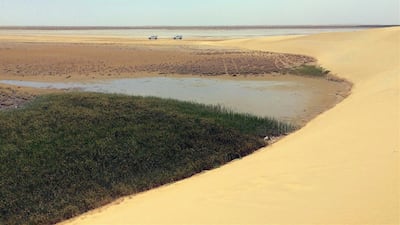Saudi Arabia's festivals are currently acting as the tourism gateway for the Middle Eastern country but it won't be too long before the Kingdom expands its offerings further. That's good news for visitors who'll have plenty to see from ancient archaeological sites and the rock-hewn tombs of the Nabataeans to natural springs and a Red Sea coastline that's waiting to be explored.
Al-Ahsa Oasis
Home to more than 2.5 million date palms, Al-Ahsa Oasis is listed in the Guinness Book of World Records as the largest oasis on Earth. Sandwiched between Riyadh and Dammam and stretching over the Empty Quarter, it was added to Unesco's list of World Heritage Sites last year. While rainfall there is scarce, the area is extremely verdant, thanks to a huge natural underground aquifer that turns the land into fertile soil, so the oasis produces five tonnes of some of the best dates in the world every day. There are also more than 60 natural springs, a huge lake, historical buildings and ancient archaeological sites where history buffs can trace details all the way back to the Neolithic period.
Al Hijr Archaeological Site

If it's ancient ruins in a Bedouin land that you seek, then Al Hijr is a must-visit. Also known as Madain Saleh, in 2008 it became the first Unesco World Heritage Site in Saudi Arabia. If Jordan's Petra represents the northern capital of the Nabateans, then Al Hijr represents the south. It is nicknamed "the capital of monuments", no mean feat given that Saudi Arabia has some 4,000 archaeological sites. Wander this one site and discover rock carvings, ruins and more than 100 monumental tombs. Thanks to its location as an important crossroads in travel and trade routes for many years, many of the detailed facades are also inscribed with a medley of languages, scripts and art forms.
Historic Jeddah

A point of great importance for traders and pilgrims for centuries, Historic Jeddah was traditionally the gateway to Makkah for all Muslims arriving in the Kingdom by boat. Nestled on the eastern shore of the Red Sea, this site was added to the World Heritage list in 2014 and is a world away from the modern metropolis that we know the city of Jeddah to be today. Wander the labyrinthine streets and twisted cul-de-sacs of the old town to discover traditional architectural styles peppered with influences from all over the world. It is known for its imposing tower houses – multistorey structures built by the merchant classes that are unique in the region. They showcase large wooden window enclosures, intricate stonework and no lack of marble. As one of the best preserved examples, Naseef House is worth a visit.
Rock art in the Hail Region

Once upon a time, in the hills of Al Hail, ancient civilisations made use of freshwater resources to feed animals, raise families and grow crops. The societies later vanished, but what they left behind is fascinating. This Unesco site is spread across two areas, one at Jebel Umm Sinman Jubbah and the other 250 kilometres south of Hail at Jabel Al-Manjor and Jabal Raat at Shuwaymis. Between them, they offer an amazingly intricate selection of rock art, one of the world's oldest continuously practised art forms. Well-preserved carvings of people and animals, including camels, ibex, ostriches, and oryx, depict a detailed record of the world from days gone by.



